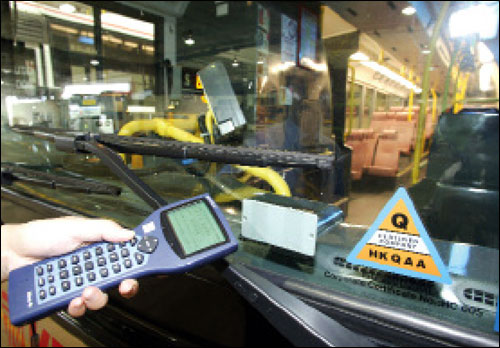Presented below is part four of an 11-part series examining the use of radio frequency identification for unexpected applications. In this chapter, we consider RFID’s use in the world of transportation.
27. Park It Here
San Francisco deployed a network of active wireless sensors that detect where and when cars are parked. It helps the city determine when parking usage is greatest, decide if higher fees might be appropriate and discern where and when drivers fail to feed the meters—and an application for mobile phones helps drivers find available spots. (See SF Uses Wireless Sensors to Help Manage Parking.)
|
|
28. Recharging Electric Cars
Coulomb Technologies is installing networked stations that drivers of electric vehicles can use to charge up their cars’ batteries. To get the power flowing, drivers—who subscribe for either pay-as-you-go or monthly unlimited access to the stations—use RFID-based ID cards or key fobs. (See RFID Is the Key to Electric Vehicle Recharging Stations.)
29. Faster Airline Check-In
Quantas’ frequent fliers can use RFID-enabled loyalty cards to check in themselves and their luggage; the card also serves as a permanent boarding pass. Air New Zealand provides frequent fliers with a reusable RFID-enabled ePass that can be attached to their mobile phones, to check baggage, access passenger lounges and board planes without paper documents. Other airlines are piloting check-in programs that rely on mobile phones equipped with Near-Field Communication technology. (See Qantas Launches Its Next Generation Check-in System, Air New Zealand Readies for RFID-Enabled Boarding Passes and RFID Makes Check-in Faster for Air France Passengers.)
30. Access for the Blind
By 2013, national and European Union regulations require that public transit operators across Europe provide more information for blind and visually impaired riders. A Swiss public transport agency introduced an RFID-based system that lets blind riders check transit information at bus stops, as well as determine the destination of passing buses and flag them down. Riders use an RFID-enabled device to communicate with tagged buses and signs. (See Swiss Town Rolls Out RFID System for Blind Bus Riders.)
31. The Wheels on the Bus Go RFID
In Hong Kong, one of the most densely populated areas in the world, there aren’t enough parking spaces for all the cars and other vehicles. That presented a big problem for the Kowloon Motor Bus Company (KMB), the city’s largest provider of bus services. The 78-year-old company, with its fleet of 3,933 buses, transports 2.7 million passengers every day—but it has no dedicated parking spots. Every day, field staff had to record where each bus was parked, so bus captains (drivers) could find their assigned vehicles without wasting time. “The use of paper and pen in the recording process was time-consuming and prone to human error,” says Tommy Leung, head of KMB’s IT department.
“We thought the application of RFID in identifying buses would help to replace the manual process,” Leung says. Although KMB officials considered using bar codes, the approach was rejected due to difficulty reading the labels on buses at night and in the rain.
KMB developed its RFID-based Traffic Operations Management System to locate buses and improve other processes. RFID has proven an ideal technology for bus location tracking and management, Leung says. “Workflow has been streamlined, time-consuming paperwork has been drastically reduced and duplication eliminated, resulting in considerable time savings and improved data accuracy,” he says.
The system, which slashed the time required for drivers to sign in and receive their duty sheets from minutes to seconds, is also popular with KMB staff, Leung adds. “The quick duty-dispatching time greatly reduces the work pressure of bus captains and field staff,” he says. (In 2009, KMB was presented with the Best EPC/RFID Implementation Gold Award by GS1 Hong Kong.)
Kowloon isn’t the only mass-transit agency taking advantage of RFID’s ability to pinpoint vehicle locations. Similar organizations worldwide, such as Montreal’s Agence métropolitaine de transport, also are embracing the technology (see RFID Puts Montreal on a New Transit Route). “A number of overseas visitors have shown deep interest in this application,” Leung says.
RFID in mass transit isn’t only about improving efficiency; there’s also a customer-service advantage. “You can get real-time updates in terms of traffic or departure and arrival times,” says Michael J. Liard, an RFID industry analyst at ABI Research. Then, there are the benefits to be obtained by streamlining maintenance, repair and overhaul activities. When a bus arrives at the depot, the RFID system “alerts the staff that the bus is in the depot; then the maintenance workers can attend to the vehicle and store information on the tag about the service that’s been performed,” he says. “These are innovative uses, new uses, by bus depots and public transit authorities.”
Keeping buses rolling with RFID results in satisfied riders, Leung says. “KMB reinforces its position in providing reliable and value-for-money bus services to the public,” he adds.
32. In-Flight Entertainment
Jetstar, a budget airline, provides passengers with iPads preloaded with movies, TV shows, music, e-books, news and games. To ensure the much-loved mobile devices don’t disembark with passengers, each iPad contains an RFID tag. At the end of a flight, an attendant can use an RFID reader to detect any devices that haven’t been returned. (See Air Transport Industry Weighs Benefits of RFID.)
33. Car-Sharing
Hundreds of thousands of drivers worldwide prefer car-sharing to owning their own wheels, because of the environmental, social and financial benefits. Some businesses also maintain a pool of cars for use by employees. RFID helps make car-sharing practical by providing an authentication mechanism—an RFID-enabled card or fob—to ensure that only authorized members can slip behind the wheel and drive away. (See RFID Is Key to Car Clubs’ Success and The Green Technology.)
34. Bike Rentals
In cities around the world, bike-sharing programs provide commuters and tourists with a convenient, zero-emissions transportation alternative. The programs rely on RFID-enabled cards to access and/or pay for the rental bicycles. In Lyon, France, for example, residents can use their prepaid smart cards to rent bikes from 175 locations across the city and its suburbs. In Denver, infrequent riders can use a credit card to rent a bike at a station’s kiosk; regular riders who purchase a membership receive an RFID card in the mail that can be used to retrieve any available bike from a station. (See Denver Rolls Along on RFID-Powered Bikes, Bike Rental Program Peddles Smart Cards, Montreal RFID-Enabled Bike Project Picks Up Speed and News Roundup: RFID-Enabled Bikes Ride Into Chicago.)
35. Clearing Customs
At international airports in several countries—including Finland, Portugal, the United Kingdom and Venezuela—travelers with RFID-enabled passports can skip long lines at customs by using automated self-service gates. The system reads the data stored in the embedded RFID inlay and a camera captures a facial image. If the information matches what the government collected when it issued the passport, the gate allows the traveler to proceed. (See Self-Service Border Control and Air-Transport Industry Weighs Benefits of RFID.)
36. Free Rides to Jobs
The WorkLink Community Van Service and its affiliate, Ship of Zion, provide free, scheduled transportation to connect people in isolated communities outside Pittsburgh to public transit—and, thus, to job training, jobs, childcare and other support services. The program depends on RFID to identify eligible people and to understand rider usage patterns. Routes, schedules and van stops can be adjusted to match changing demands. The system also enables increased accountability, by providing nonstop monitoring of van and contractor performance. In addition, the information gathered by the system ensures funders that their money is being put to good use. (See WorkLink Takes RFID for a Ride.)
Click here to read about RFID’s use in other unexpected applications.
Illustration: iStockphoto



